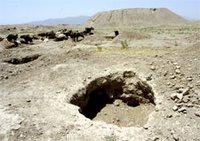An Intact Brick Dome Discovered in Arjan

Tehran, 15 April 2006 (CHN) -- Over the years the illegal excavations in Arjan, Khuzestan province caused some serious harm to this 7000-year-old historical site, but recently an intact brick dome belonging to the Islamic period was discovered at this raveged site.
“Arjan Research Center is situated in Cultural Heritage and Tourism Organization of Behbahan city and there is no building for the settlement of this center in Arjan historical site. On the other hand, the cultural heritage guards protect the area only during the days. The absence of cultural heritage guards in Arjan historical site at nights provides smugglers an opportunity to go to the site every now and then to carry out illegal diggings. However this time their excavations led to the discovery of an intact brick dome belonging to the Islamic period,” said Ganji, head of Arjan’s Research Center.
Khuzestan and Kerman provinces are known as the paradise of illegal diggers. According to Ganji, since the Arjan historical site is very vast, sometimes the research center does not get informed of some illegal excavations right away.
Arjan Elamite city is located 10 kilometers north of the city of Behbahan in Khuzestan province. A grave belonging to the New Elamite era was discovered during the construction of a dam on Maroon River in fall 1982. The grave belongs to Kidin Hutran, an Elamite king who ruled during the seventh century BC. A very unique and remarkable gold ring with the design of two winged lions on the two sides of a “holly tree” was also discovered in this grave. On this ring, a phrase written in the Elamite cuneiform is evident which reads: “Kidin Hutran, Son of Cyrus”.
Arjan historical site was a flourished city during the ancient times which stayed alive until the beginning of the Islamic period. The city underwent a lot of changes and got into conflicts with Al-e Bouye dynasty. Arjan was devastated by an earthquake in 1085 AD. Those who survived from the earthquake migrated toward the south of the area and established the present city of Behbahan.

0 Comments:
Post a Comment
<< Home